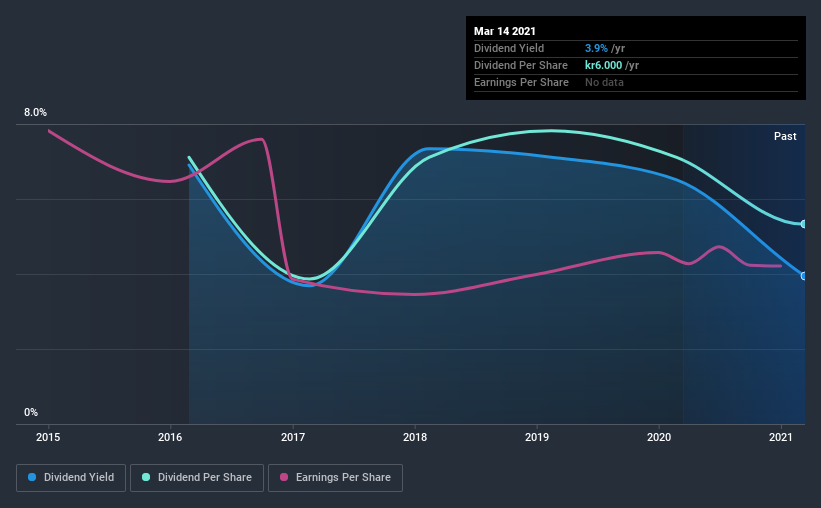Just Three Days Till Aasen Sparebank (OB:AASB) Will Be Trading Ex-Dividend

Readers hoping to buy Aasen Sparebank (OB:AASB) for its dividend will need to make their move shortly, as the stock is about to trade ex-dividend. You will need to purchase shares before the 19th of March to receive the dividend, which will be paid on the 26th of March.
Aasen Sparebank's next dividend payment will be kr6.00 per share, on the back of last year when the company paid a total of kr6.00 to shareholders. Looking at the last 12 months of distributions, Aasen Sparebank has a trailing yield of approximately 3.9% on its current stock price of NOK152. If you buy this business for its dividend, you should have an idea of whether Aasen Sparebank's dividend is reliable and sustainable. As a result, readers should always check whether Aasen Sparebank has been able to grow its dividends, or if the dividend might be cut.
Check out our latest analysis for Aasen Sparebank
Dividends are typically paid out of company income, so if a company pays out more than it earned, its dividend is usually at a higher risk of being cut. Aasen Sparebank paid out just 16% of its profit last year, which we think is conservatively low and leaves plenty of margin for unexpected circumstances.
Companies that pay out less in dividends than they earn in profits generally have more sustainable dividends. The lower the payout ratio, the more wiggle room the business has before it could be forced to cut the dividend.
Click here to see how much of its profit Aasen Sparebank paid out over the last 12 months.

Have Earnings And Dividends Been Growing?
Businesses with shrinking earnings are tricky from a dividend perspective. If business enters a downturn and the dividend is cut, the company could see its value fall precipitously. With that in mind, we're discomforted by Aasen Sparebank's 8.2% per annum decline in earnings in the past five years. Ultimately, when earnings per share decline, the size of the pie from which dividends can be paid, shrinks.
Another key way to measure a company's dividend prospects is by measuring its historical rate of dividend growth. Aasen Sparebank's dividend payments per share have declined at 5.6% per year on average over the past five years, which is uninspiring. While it's not great that earnings and dividends per share have fallen in recent years, we're encouraged by the fact that management has trimmed the dividend rather than risk over-committing the company in a risky attempt to maintain yields to shareholders.
To Sum It Up
From a dividend perspective, should investors buy or avoid Aasen Sparebank? Aasen Sparebank's earnings per share are down over the past five years, although it has the cushion of a low payout ratio, which would suggest a cut to the dividend is relatively unlikely. It doesn't appear an outstanding opportunity, but could be worth a closer look.
If you're not too concerned about Aasen Sparebank's ability to pay dividends, you should still be mindful of some of the other risks that this business faces. To help with this, we've discovered 2 warning signs for Aasen Sparebank that you should be aware of before investing in their shares.
A common investment mistake is buying the first interesting stock you see. Here you can find a list of promising dividend stocks with a greater than 2% yield and an upcoming dividend.
If you decide to trade Aasen Sparebank, use the lowest-cost* platform that is rated #1 Overall by Barron’s, Interactive Brokers. Trade stocks, options, futures, forex, bonds and funds on 135 markets, all from a single integrated account. Promoted
New: Manage All Your Stock Portfolios in One Place
We've created the ultimate portfolio companion for stock investors, and it's free.
• Connect an unlimited number of Portfolios and see your total in one currency
• Be alerted to new Warning Signs or Risks via email or mobile
• Track the Fair Value of your stocks
This article by Simply Wall St is general in nature. It does not constitute a recommendation to buy or sell any stock, and does not take account of your objectives, or your financial situation. We aim to bring you long-term focused analysis driven by fundamental data. Note that our analysis may not factor in the latest price-sensitive company announcements or qualitative material. Simply Wall St has no position in any stocks mentioned.
*Interactive Brokers Rated Lowest Cost Broker by StockBrokers.com Annual Online Review 2020
Have feedback on this article? Concerned about the content? Get in touch with us directly. Alternatively, email editorial-team (at) simplywallst.com.
About OB:AASB
Aasen Sparebank
Provides various banking products and services in Norway.
Good value with reasonable growth potential.
Market Insights
Community Narratives



